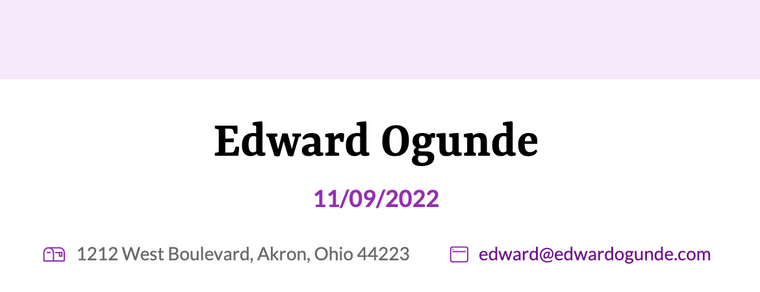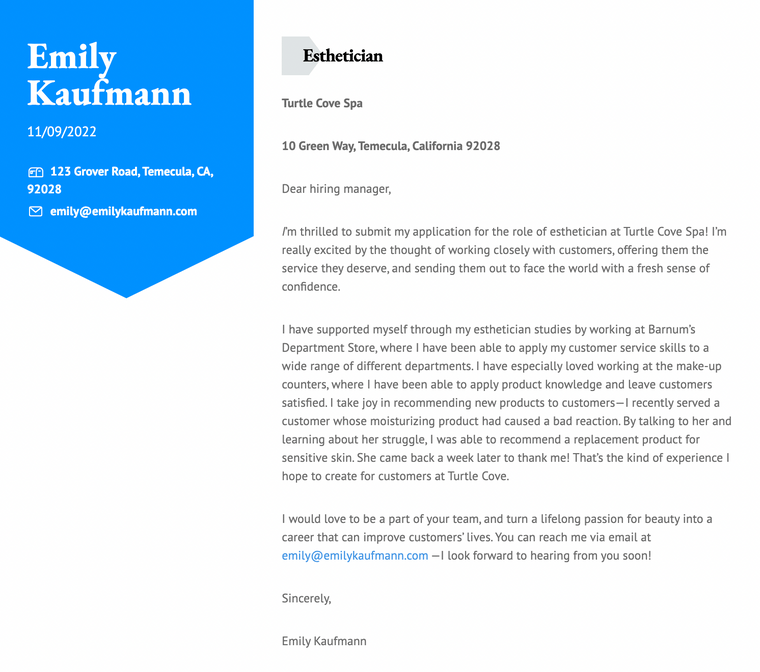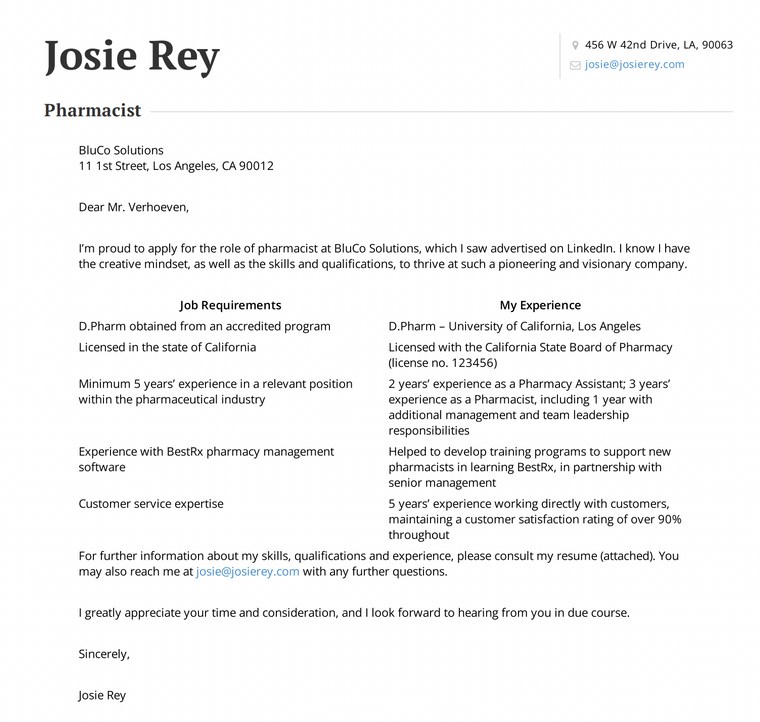How to Format a Cover Letter (With 2022 Examples)
Learning how to format a cover letter is the first step towards your dream job -- find out how to do it (including examples) here.

Your cover letter is an integral part of any job application. Your resume does the hard work of spelling out your work history and skills, but your cover letter offers something just as critical. It gives hiring managers some insight into you—your personality, your approach to work in general, and your specific understanding of the role you want.
That’s why it’s so important to take the time to format your cover letter correctly. If you’re not sure how to format a cover letter in the most effective way, we’re here to give you the advice you need! Read on, and your cover letter will stand out for all the right reasons when it’s time to submit your application.
In this guide, we’ll cover the following points:
- What makes a good cover letter format
- The best formats for formal and informal cover letters
- Some examples of great cover letters
- Some guides to different formatting approaches for cover letters
How to Format Your Cover Letter
Your cover letter needs to contain the following elements:
- A header including both your address and the company’s address
- A greeting
- An introductory paragraph
- Information about your experience, skills and achievements
- What you hope to achieve in the role you want
- A conclusion and sign-off
In most cases—regardless of whether your cover letter is formal or informal—those elements will all need to appear. While an informal style of cover letter can be a lot more flexible in its approach, under most circumstances, these components of a cover letter will usually need to appear in the order in which we’ve listed them here.
What is a Good Cover Letter Format?
The best cover letter format will vary depending on a range of factors. If you’re applying to a well-established, conservative company as a new graduate with no work experience, your cover letter will look very different from that of a candidate for a start-up job who is making a major career change. Choosing the right format is all about identifying your own strengths, as well as the culture and attitude of the company where you want to work.
In general, though, a good cover letter format will allow you to showcase your best qualities without too many visual distractions. Remember, even if you’re including a more design-heavy header or a T-shape informational table, the focus should always be on the content of the letter itself. That’s the part that will matter the most to a hiring manager.
What is the Best Formal Cover Letter Format?
If you’re applying for a company with a more formal, professional or conservative workplace culture, you need to ensure that your cover letter reflects that culture. This is an important part of showing that you will be a good fit for the position you want. As such, you’ll need to ensure that you choose the best formal cover letter format when applying for the job!
In most circumstances, companies with a formal workplace culture won’t need you to incorporate too much design or visual flair into your cover letter. The block format (explained below) is a great place to start. It puts the focus squarely on the content of your cover letter, while delivering a widely-recognized businesslike format—allowing you both to foreground your own qualifications and to prove that you understand professional norms.
Whatever format you choose, though, you’ll need to pay attention to the little details when formatting a formal cover letter. Make sure that it opens with your address, followed by your location and the date. You’ll then need to include the contact address of your prospective employer. It should look something like this:
Edward Ogunde 1212 West Boulevard Akron, Ohio 44223 edward@edwardogunde.com Akron, 11/09/2022

Joanna Chiu Head of Software Development Nyoom, Inc 39 Circle Drive Columbus, Ohio 43004 Columbus, 11/09/2022
You should also make sure that your cover letter contains a formal greeting and a formal sign-off. “Dear Ms Chiu,” in the example above, would work very well—and if you don’t know the name of your contact at the company, “Dear Hiring Manager” is the best generic substitute. At the end, you should sign off with “Sincerely,” and your full name.
What is the Best Informal Cover Letter Format?
Certain companies take pride in their more informal workplace culture. This is most common in start-ups, tech companies, and companies designing or making products for younger generations. If you’re hoping to find work at one of these companies, showing that you can get to grips with a less formal approach is an important part of landing the job you want.
Remember, informal doesn’t mean unprofessional! Even if you’re in a position to take a less formal tone in your cover letter, it should still look put-together and stylish. Ultimately, an informal workplace is still a workplace, and you need to show that you can present yourself well in a high-stakes situation.
For a more informal cover letter, you could try experimenting with colors and other design elements. A more colorful or stylish header could catch a hiring manager’s attention, for example, as could incorporating a second column for your contact information and address. You can enjoy a lot more aesthetic freedom with an informal cover letter than with a formal one—though, as discussed, you should still keep things as professional as you can.
Cover Letter Format Examples
Want some examples to help you get started on your own cover letter? We’ve included some example cover letters below, as well as some advice about why each one works so well. Read on!
Esthetician Cover Letter Formatting Example
Emily Kaufmann 123 Grover Road Temecula, CA 92028 emily.k.beauty@gmail.com
Temecula, 11/09/2022
Turtle Cove Spa 10 Green Way Temecula, CA 92028
Dear hiring manager,
I’m thrilled to submit my application for the role of esthetician at Turtle Cove Spa! I’m really excited by the thought of working closely with customers, offering them the service they deserve, and sending them out to face the world with a fresh sense of confidence.
I have supported myself through my esthetician studies by working at Barnum’s Department Store, where I have been able to apply my customer service skills to a wide range of different departments. I have especially loved working at the make-up counters, where I have been able to apply product knowledge and leave customers satisfied. I take joy in recommending new products to customers—I recently served a customer whose moisturizing product had caused a bad reaction. By talking to her and learning about her struggle, I was able to recommend a replacement product for sensitive skin. She came back a week later to thank me! That’s the kind of experience I hope to create for customers at Turtle Cove.
I would love to be a part of your team, and turn a lifelong passion for beauty into a career that can improve customers’ lives. You can reach me via email at emily.k.beauty@gmail.com—I look forward to hearing from you soon!
Sincerely,
Emily Kaufmann*

This cover letter takes a more informal tone, because it’s addressed to a local business where taking a friendly, approachable stance with customers is important. Despite that informality, it ticks every box: It includes all the necessary elements of a cover letter, its salutation and sign-off are appropriately professional, and its header contains all the information required.
Pharmacist Cover Letter

This cover letter is clearly geared toward a more formal, corporate company—and its tone is suitably professional. It uses a T-shape format to capture the exact ways in which the candidate meets the requirements of the role, without getting bogged down in anecdotes or details. For such a technical position, this cover letter is a great fit.
How Do You Write a Cover Letter in MLA Format?
The Modern Language Association (MLA) style of writing is most commonly used in academic contexts. So if you’re applying for an academic job, you may wish to consider writing a cover letter in MLA format. While this format has a lot in common with regular cover letter formats, it also has some crucial differences that make the most sense when applied to the academic job market.
In particular, a MLA cover letter is more likely to refer to your academic background than to any previous work experience. You should be prepared to write about how your previous studies in your field have prepared you for the job you want. You’ll also need to include a paragraph about the current status of your dissertation—whether you’ve completed it, the general topic it covered, and the broad-strokes findings of your work.
How to Write a T-Shape Cover Letter Format
A T-shape cover letter directly compares your skills, experience and qualifications to the requirements of the job you want. It’s called a T-shape cover letter because of the way it looks when formatted correctly. It includes a chart that splits the page into two columns—like the downward stroke of a capital letter T.
This format works because it’s easy for hiring managers to read through at a glance. It gives them a simple framework in with to assess your suitability for the role. Most importantly, it doesn’t leave them searching for useful information in a big block of text!
Writing a T-shape cover letter is simple. Once you’ve written your salutation and introductory paragraph, you can create a two-column table with the job requirements on the left and your own experience on the right. Each row of the table should contain a specific job requirement on one side, and the ways in which you meet that requirement on the other.
Done right, the table in a T-shape cover letter format should look something like this:

How Do You Write a Block Format Cover Letter?
The block format does what it says on the tin. It’s a cover letter written in paragraphs with no indentations, with line breaks between each paragraph. All the margins are left-justified, with no additional formatting involved—no elaborate headers, no T-shape tables, and no graphics.
A block format cover letter is easy to put together. Select a standard, readable font, justify everything to the left, and remove any default indentation in your document. From there, it’s a simple matter of typing out your cover letter and getting it ready to send!
This format doesn’t require any extra tricks or conceits beyond its visual layout. All that matters is writing a strong cover letter. As long as you include all the elements listed at the beginning of this guide, you’ll end up with a great final product.
The block format is widely recognized as a professional, businesslike format. It’s easy to read, with no visual distractions to take attention away from the content of your cover letter. If you’re applying for a job at a more conservative or formal institution, a block format cover letter is an approach that will work well for you.
Copyright ©2024 Workstory Inc.